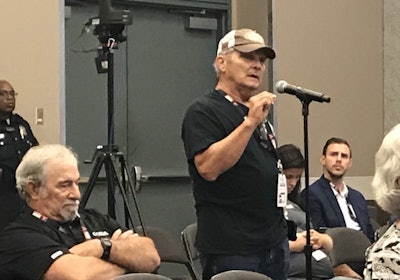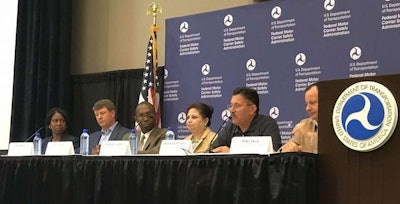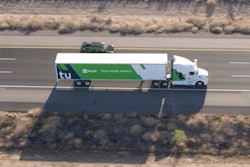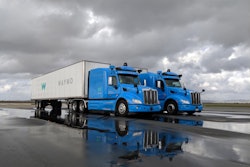 Long-time trucker Steve Davenport voiced his concerns about the costs associated with automated driving technologies. Other drivers present at the session voiced concern over the potential loss of trucking jobs with the implementation of systems that take control away from drivers.
Long-time trucker Steve Davenport voiced his concerns about the costs associated with automated driving technologies. Other drivers present at the session voiced concern over the potential loss of trucking jobs with the implementation of systems that take control away from drivers.A potential loss of truck driving jobs and the loss of the human element were the two biggest talking points for truckers during a listening session Friday at the Great American Trucking Show with Federal Motor Carrier Safety Administration officials about the future implementation of automated driving systems and autonomous trucks.
Six representatives from the Federal Motor Carrier Safety Administration were on hand for the session, including Ray Martinez, administrator; Wiley Deck, director of governmental affairs; Larry Minor, associate administrator for policy; Colleen Coggins, acting chief information officer; Selika Gore, senior advisor to the administrator; and Jim Mullen, chief counsel. The session was the third held by the agency across the country on the topic but the first geared specifically toward drivers.
Martinez said FMCSA’s goal with the sessions is to be proactive about regulations regarding autonomous trucks because these systems are already in development and in some cases are being tested. He said the goal of the Dallas session was specifically to hear from the trucking industry and the people who are on the roads working day-to-day.
“You’re busy with what’s happening today, what’s happening this year or in the next two years, but this is really looking toward the future,” he said to the truckers in attendance. “We want to learn from truckers’ expertise regarding vehicle operations.”
Several drivers voiced concerns over the potential loss of jobs with the implementation of autonomous trucks, specifically level 4 and level 5 autonomous trucks that could operate in most conditions without a driver present. Another point of concern for drivers at the session was the loss of the human element when things go wrong on the road and lanes need to be cleared for emergency personnel to be able to reach the scene of an accident.
Taylor Aho, an owner-operator who drives team with her husband, pointed to automation in other industries, such as with check-out lanes at Walmart.
“You look at all automation when it comes to a business, there’s less employees,” she said. “You used to go into Walmart and have checkers, and then all of a sudden there’s automated lanes and one checker. It’s a fact of modernization. Every time something gets automated, people lose jobs.”
Aho noted the current generation of drivers may not see the job loss effects, but future generations would see that impact.
“What about my kids and grandkids if they want to drive?” Aho added. “I do believe it’s going to affect the future. How quickly? Maybe not in my lifetime, but in my descendants’ lifetimes.”
 Six FMCSA representatives participated in a listening session Friday at GATS about autonomous trucks and technology. From left are: Selika Gore, senior advisor to the administrator; Jim Mullen, chief counsel; Larry Minor, associate administrator for policy; Colleen Coggins, acting chief information officer; including Ray Martinez, administrator; and Wiley Deck, director of governmental affairs.
Six FMCSA representatives participated in a listening session Friday at GATS about autonomous trucks and technology. From left are: Selika Gore, senior advisor to the administrator; Jim Mullen, chief counsel; Larry Minor, associate administrator for policy; Colleen Coggins, acting chief information officer; including Ray Martinez, administrator; and Wiley Deck, director of governmental affairs.Martinez responded to Aho’s concerns and agreed that automation may not come in this generation but maybe the next. He added, however, that maybe the job of truck driver becomes more of a truck technician who is working with truck technology rather than driving one. A job would still be there, but it would be different from what a truck operator is considered today, Martinez said. He equated the future evolution of the trucking industry to what the airline industry has seen with the introduction of autopilot.
“They still need that pilot, and when a storm hits, the hand is on the throttle, along with take-off and landing,” Martinez added.
Long-time trucker and owner-operator Steve Davenport said economics should be considered as automated driving technologies emerge.
“There’s not enough attention being paid to the economics of these technologies,” Davenport said. “If we’re going to be progressive in this industry, we need to think about things economically and be cost-sensitive and to the drivers’ advantage.”
In regard to safety and the safety of automated driving systems, Davenport said he has been a safe driver throughout his nearly 50-year trucking career and technology has been used “to take that part of me away.”
Aho returned to the microphone during the session to tell a story about a recent trip through Utah when she and her husband watched an accident occur ahead of them in which a car with four occupants flipped on its side. She said they blocked the travel lanes of the interstate and her husband directed traffic to free up a lane for emergency personnel to arrive while Aho, a former EMT and medic, got out and took care of an infant that was in the overturned car while other bystanders helped the other occupants.
“If you have several lanes of automated trucks, they’re going to stop, but no one’s going to get through with emergency personnel,” she said. “We’ve seen so many accidents with lines of trucks on the road where the only lane open is the pass-through lane on the far left. If someone doesn’t get out and direct traffic and take care of people, how does emergency personnel get through?”
Owner-operator John Stanton weighed in on the opposite side of the argument, saying technology isn’t necessarily the enemy. He said automation could lead to an owner-operator not being behind the wheel but rather in their own home.
“What if I could drive my own truck autonomously from my living room?” he said. “Instead of owning the Kenworth or Peterbilt that I drive, maybe I own a Kenworth or Peterbilt that I control from my living room, so now I don’t have to be out there. What if I can do my 70-hour work week from home?”









